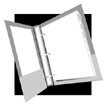|
|
Reading List: 1. Excerpt (4th story) from The Near Enemy of the Humanities is Professionalism, by Lisa Ruddick. The Chronicle Review, Section 2. The Chronicle of Higher Education, November 23rd, 2001. Volume XLVIII, Number 13, P. B9. Washington, DC. 2. Modern Op: Bridget Riley..., by Michael Kimmelman. The New York Times Magazine, August 27, 2000, P. 47 3. Design Interactive Education, Max Bruinsma, in The Education of the Graphic Designer, Ed. by Steven Heller. Allworth Press, New York, 1998. P57. ISBN 1-880559-99-4 4. Upheavals of Thought: The Intelligence of the Emotions,by Martha Nussbaum. Cambridge University Press, 2001. PP. 364-368 Mercy Without Compassion. ISBN 0-521-46202-9
Informative Handouts: Beautifully illustrated Basic Pen Strokes and Thier Uses and Common Mistakes from Rendering in Pen and Ink by Arthur L Guptill. Watson and Guptill Publications, 1976
Additional Information artist - Able to isolate basic equations from all of the incoming visual stimuli (Art, Design and Visual Culture. Malcolm Barnard, St. Martins Press, NY, 1998, p.2) visual Art / culture - material artifacts, buildings and images, plus time based media and performance - ... produced by human labor and imagination, which serve aesthetic, symbolic, ritualistic or ideological-political ends, and or practical functions, and which address the sense of sight to some effect. (Art, Design and Visual Culture. Malcolm Barnard, St. Martins Press, NY, 1998, p.2) intuitiveness - a sense of immediacy and purpose with the media, pushing, pulling and stretching of an idea into form open-mindedness - learning how the principles work so you'll be alert for your own discoveries intellectual work - intake of new information, relate past experiences to solving of present visual problem, and to develop new problems to solve design - endow optical sensations, or images, with meaning
Bibliography The coursework is a select compilation of other peoples research into the visual nature of art. Click here to browse the list of resources used. |
